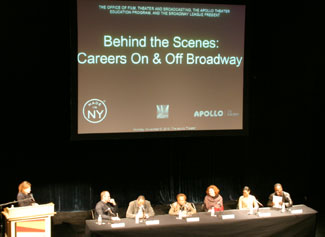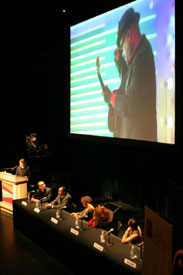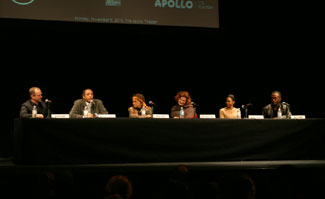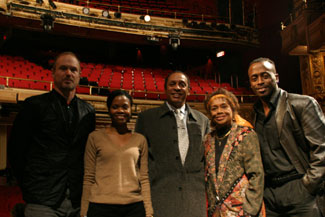 Photo of the OFTB banner, 53rd Street, Manhattan 
| |||
|
| |||
Theatre Professionals Share Their Success Stories About Working On and Off Broadway at "Behind the Scenes"  November 10, 2010 - The bright lights of Broadway came to the Apollo Theater on Monday, November 8, 2010, thanks to the combined efforts of the Mayor’s Office of Media and Entertainment, the Apollo Theater Education Program, and the Broadway League. Behind the Scenes: Careers On and Off Broadway featured six talented backstage professionals who have built successful careers on Broadway and other theatrical venues in creative roles such as set, lighting and costume design, choreography and music composition.
November 10, 2010 - The bright lights of Broadway came to the Apollo Theater on Monday, November 8, 2010, thanks to the combined efforts of the Mayor’s Office of Media and Entertainment, the Apollo Theater Education Program, and the Broadway League. Behind the Scenes: Careers On and Off Broadway featured six talented backstage professionals who have built successful careers on Broadway and other theatrical venues in creative roles such as set, lighting and costume design, choreography and music composition.
The panel was moderated by NY1 anchor and theater critic Roma Torre, who began the event by introducing short videos that gave the audience a glimpse of the panelists’ career highlights.  Kevin Adams, a lighting designer whose stage credits include Spring Awakening, American Idiot and Next to Normal, got his start in the business by studying set design. He developed an interest in lighting after observing ways in which artists used light to enhance museum exhibits. He then asked a director if he could try lighting a set he had designed (pro-bono of course), and gradually began developing a reputation in the industry as a talented lighting designer. “I started getting more and more phone calls,” he recalled. “The city was very kind to me.” Kevin Adams, a lighting designer whose stage credits include Spring Awakening, American Idiot and Next to Normal, got his start in the business by studying set design. He developed an interest in lighting after observing ways in which artists used light to enhance museum exhibits. He then asked a director if he could try lighting a set he had designed (pro-bono of course), and gradually began developing a reputation in the industry as a talented lighting designer. “I started getting more and more phone calls,” he recalled. “The city was very kind to me.”
Micki Grant, a veteran composer/lyricist, playwright/librettist and actress who has been involved in the creation of at least eighteen theatrical productions, always knew she was going to have a career in theater and music. “I feel extraordinarily blessed to have spent the majority of my life doing what I had always wanted to do since I was eight years old. You have to love it so much that you can’t imagine ever doing anything else.” The panel also included composer, pianist and musical director Kenny Seymour, who is currently working as the conductor and musical director for Memphis – A New Musical, now in its second year on Broadway and the winner of the 2010 Tony Award for Best Musical. He stressed the importance of education in pursuing a career in theater. “You need to not only have a creative vision, but also the technical background to be able to realize that vision.” Marion Caffey, writer, director and choreographer of such hits as 3 Mo’ Tenors and 3 Mo’ Divas, agreed with Seymour’s assessment. “I make sure I surround myself with people who are extremely educated in their field when I direct a show.”  When asked what a playwright can do to jumpstart their career, panelists recommended numerous collaborative organizations throughout the city that allow young artists to experiment and try out new ideas. Going to the River (GTTR) provides a New York City forum for professional African-American female playwrights to develop, refine and present their work. The Harlem-based Frank Silvera Writer’s Workshop continues to deliver on its mission of reading, developing and showcasing exciting work from playwrights of all colors and backgrounds. There are also numerous mentoring programs available for aspiring playwrights and theater professionals, such as the Obie Award-winning Mentor Project with Cherry Lane Theater, which engages leading dramatists in one-on-one mentoring relationships with emerging playwrights for an entire theater season. It’s about getting your work in front of someone, the panelists emphasized. When asked what a playwright can do to jumpstart their career, panelists recommended numerous collaborative organizations throughout the city that allow young artists to experiment and try out new ideas. Going to the River (GTTR) provides a New York City forum for professional African-American female playwrights to develop, refine and present their work. The Harlem-based Frank Silvera Writer’s Workshop continues to deliver on its mission of reading, developing and showcasing exciting work from playwrights of all colors and backgrounds. There are also numerous mentoring programs available for aspiring playwrights and theater professionals, such as the Obie Award-winning Mentor Project with Cherry Lane Theater, which engages leading dramatists in one-on-one mentoring relationships with emerging playwrights for an entire theater season. It’s about getting your work in front of someone, the panelists emphasized.
Torre commented to the panelists that success in the theater industry can usually be boiled down to three main factors: talent, luck, and hard work. When asked which of those three were the most important, the panelists unanimously agreed. “Hard work is definitely the most important,” Grant declared. Seymour pointed out that “You start with talent, but you have to take the time to turn that talent into true craftsmanship.” Adams commented that you have to make your own luck in the theater.
The panelists also discussed the frequency of rejection in the business, and the fact that it was just part of the territory. “You have to be like a bouncing ball,” Grant advised. “People in the theater world are unique in that their career is always looking for the next job. Rejection should not bring on dejection.” Ruthlyn Salomons, resident dance supervisor of Broadway’s The Lion King, added, “You have to have an incredible amount of confidence in what you want to do.” Salomons has also worked as the associate choreographer of The Color Purple and has performed and traveled worldwide with dance companies including the Alvin Ailey American Dance Theater, the White Oak Dance Project and Donald Byrd/The Group. “If you work hard, keep your focus and leave yourself open to new possibilities, amazing opportunities can present themselves to you.” | |||
 |
